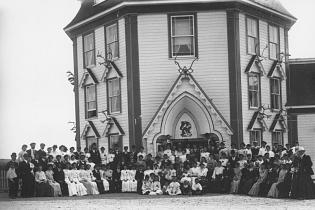Was Charles Danielle out and proud in 1800s St. John’s?
ST. JOHN'S, N.L. —
He was the owner of an opulent castle resort said to be the Fogo Island Inn of its day, and his funeral drew hundreds, including the high society of St. John’s, but he may also have a prominent role in the lesbian, gay, bisexual and transgender plus (LGBT+) history of Newfoundland and Labrador.
Charles Henry Danielle, who went by the title “professor,” as he taught dance and was a costume maker besides resort owner and restaurateur, is believed to have been gay and proud of it.
According to an article in the "Dictionary of Canadian Biography," the never-married Danielle left his estate to Frederick A. Brazill, his ward and assistant, “about whom little is known.”
A crowd is gathered at the west end of Water Street, St. John's to see Prof. Charles Henry Danielle's 1902 funeral train. He was a dance teacher, restauranteur, costume maker and resort owner and was most likely gay. His pallbearers included Sir William Whiteway and Sir James Spearman Winter. ROBERT EDWARDS HOLLOWAY AND JAMES VEY COLLECTION/THE ROOMS PROVINCIAL ARCHIVES VA 85-79
First arriving in St. John’s in the 1860s, and later returning to build the late-1800s, first-class resort Octagon Castle, Danielle may have been relatively open about his lifestyle. If he was, people didn’t seem to care much — people flocked to the resort, including the most prominent members of society. Hundreds lined the street for his funeral in 1902 and his pallbearers were the high and mighty of the day.
Larry Dohey is the director of programming and public engagement at The Rooms. He is the author of the Archival Moments blog.
Larry Dohey, director of programming and public engagement at The Rooms, is inclined to agree Danielle was gay.
Besides the clues in Danielle’s backstory, he fit the stereotypical profile of a skilled decorator. He was flamboyant and the word “eccentric” 150 years ago could well be a descriptor for someone who was gay. (The term gay was not in use to refer the same-sex community until well into the 20th century.)
“He was very comfortable with who he was,” said Dohey, who has written about the castle in his Archival Moments blog.
“Some people would say he had a big personality.”
Octagon Castle, opened in 1896, was destroyed by fire in 1915. It was four stories in height and covered 3,750 square feet of land, according to an Archival Moments’ article about it.
Danielle, according to the dictionary, was born in Baltimore, Md., and had taught dance in Chicago, Ill.
It’s believed he might have been attracted to St. John’s by American businessman Cyrus West Field’s attempts to lay a transatlantic cable to the island in the 1850s and 1860s.
He started a skating rink near Government House (think the Loop 1800s style). But life wasn’t all that smooth for him in those early days — someone burned the rink down in 1878, according to the dictionary.
He left Newfoundland, but returned in 1888, opening a restaurant on Water Street.
The castle, then the Royal Lake Pavillon, was built on Quidi Vidi Lake with an interior done up in oriental style. The ballroom accommodated 1,500 people, according to Archival Moments. But a racket with his landlord prompted him to disassemble it and move it to what is now known as Octagon Pond.
Journalists from around the world came to see and write about the resort, most noticeably “The World,” the most successful of the New York papers, in 1898.






